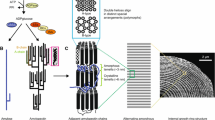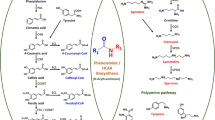Abstract
A polygalacturonase inhibitor protein (PGIP) was characterized from tomato fruit. Differential glycosylation of a single polypeptide accounted for heterogeneity in concanavalin A binding and in molecular mass. Tomato PGIP had a native molecular mass of 35 to 41 kDa, a native isoelectric point of 9.0, and a chemically deglycosylated molecular mass of 34 kDa, suggesting shared structural similarities with pear fruit PGIP. When purified PGIPs from pear and tomato were compared, tomato PGIP was approximately twenty-fold less effective an inhibitor of polygalacturonase activity isolated from cultures of Botrytis cinerea. Based on partial amino acid sequence, polymerase chain reaction products and genomic clones were isolated and used to demonstrate the presence of PGIP mRNA in both immature and ripening fruit as well as cell suspension cultures. Nucleotide sequence analysis indicates that the gene, uninterrupted by introns, encodes a predicted 36.5 kDa polypeptide containing amino acid sequences determined from the purified protein and sharing 68% and 50% amino acid sequence identity with pear and bean PGIPs, respectively. Analysis of the PGIP sequences also revealed that they belong to a class of proteins which contain leucine-rich tandem repeats. Because these sequence domains have been associated with protein-protein interactions, it is possible that they contribute to the interaction between PGIP and fungal polygalacturonases.
Similar content being viewed by others
References
Abu-Goukh AA: Polygalacturonase inhibitors in the ‘Bartlett’ pear. Ph.D. thesis, University of California, Davis, CA (1982).
Abu-Goukh AA, Strand LL, Labavitch JM: Development-related changes in decay susceptibility and polygalacturonase inhibitor content of ‘Bartlett’ pear fruit. Physiol Plant Path 23: 101–109 (1983).
Abu-Goukh AA, Greve LC, Labavitch JM: Purification and partial characterization of ‘Bartlett’ pear polygalacturonase inhibitors. Physiol Plant Path 23: 111–122 (1983).
Abu-Goukh AA, Labavitch JM: The in vivo role of ‘Bartlett’ pear fruit polygalacturonase inhibitors. Physiol Plant Path 23: 123–135 (1983).
Albersheim P, Anderson AJ: Proteins from plant cell walls inhibit polygalacturonases secreted by plant pathogens. Proc Natl Acad Sci USA 68: 1815–1819 (1971).
Bernatzky R, Tanksley SD: Genetics of actin-related sequences in tomato. Theor Appl Genet 72: 314–321 (1986).
Brown AE, Adikaram NKB: A role for pectinase and protease inhibitors in fungal rot development in tomato fruits. Phytopath Z 106: 249–251 (1983).
Cervone F, Hahn MG, De Lorenzo G, Darvill A, Albersheim P. Host-pathogen interactions. XXXIII. A plant protein converts a fungal pathogenesis factor into an elicitor of plant defense responses. Plant Physiol 90: 542–548 (1989).
Collmer A, Keen NT: The role of pectic enzymes in plant pathogenesis. Annu Rev Phytopath 24: 383–409 (1986).
Degra L, Salvi G, Mariotti D, De Lorenzo G, Cervone F: A polygalacturonase-inhibiting protein in alfalfa callus cultures. J Plant Physiol 133: 364–366 (1988).
Deikmann J, Fisher RL: Interaction of a DNA binding factor with the 5′-flanking region of an ethylene-responsive fruit ripening gene from tomato. EMBO J 7: 3315–3320 (1988).
Egli MA: Polygalacturonase inhibitors in green and ripened ‘Bartlett’ pears. M.Sc. thesis, University of California, Davis, CA (1987).
Gross KC: A rapid and sensitive spectrophotometric method for assaying polygalacturonase using 2-cyanoacetamide. Hort Science 17: 933–934 (1982).
Hashimoto C, Hudson KL, Anderson KV: The Toll gene of Drosophila, required for dorsal-ventral embryonic polarity, appears to encode a transmembrane protein. Cell 52: 269–279 (1988).
Hoffman RM, Turner JG: Occurrence and specificity of an endopolygalacturonase inhibitor in Pisum sativum. Physiol Plant Path 24: 49–59 (1984).
Johnston DJ, Ramanathan V, Williamson B: A protein from immature raspberry fruits which inhibits endopolygalacturonases from Botrytis cinerea and other microorganisms. J Exp Bot 44: 971–976 (1993).
Karp DR, Atkinson JP, Shreffler DC: Genetic variation in glycosylation of the fourth component of murine complement. J Biol Chem 257: 7330–7335 (1982).
Kataoka T, Broek D, Wigler M: DNA sequence and characterization of the S. cerevisiae gene encoding adenylate cyclase. Cell 43: 493–505 (1985).
Laemmli UK Cleavage of structural proteins during assembly of the head of bacteriophage T4. Nature 227: 680–685 (1970).
Lafitte C, Barthe JB, Montillet JL, Touzé A: Glycoprotein inhibitors of Colletotrichum lindemuthianum on dopoygalacturonase in near isogenic lines of Phaseolus vulgaris resistant and susceptible to anthracnose. Physiol Plant Path 25: 39–53 (1984).
Lee FS, Vallee BL. Modular mutagenesis of human placental ribonuclease inhibitor, a protein with leucino-rich repeats. Proc Natl Acad Sci USA 87: 1879–1883 (1990).
Leone G: In vivo and in vitro phosphate dependent polygalacturonase production by different isolates of Botrytis cinerea. Mycol Res 94: 1039–1045 (1990).
Leone G, Van den Heuvel J: Regulation by carbohydrates of the sequential in vitro production of pectic enzymes by Botrytis cinerea. Can J Bot 65: 2133–2141 (1987).
Lopez JA, Chung DW, Fujikawa K, Hagen FS, Papayannopoulou T, Roth GJ: Cloning of the a chain of human platelet glycoprotein Ib: A transmembrane protein with homology to leucine-rich 616–1. Proc Natl Acid Sci USA 84: 5615–5619 (1987).
Maniatis T, Fritsch EF, Sambrook J: Molecular Cloning A Laboratory Manual. Cold Spring Harbor Laboratory Cold Spring Harbor, NY (1982).
Oakley BR, Kirsch DR, Morris NR: A simplified sensitive silver stain for detecting proteins in polyacrylamide gels. Anal Biochem 105: 361–363 (1980).
O'Farrell PZ, Goodman HM, O'Farrel PH: High resolution two-dimensional electrophoresis of basic as well as acidic proteins. Cell 12: 1133–1142 (1977).
Ohkura H, Yanagida M: S. pombe gene sds22 + essential for a midmitotic transition encodes a leucine-rich repeat protein that positively modulates protein phosphatase-1. Cell 64: 149–157 (1991).
Reid AR, John MC, Amasino RM: Deoxyribonuclease I sensitivity of the T-DNA ipt gene is associated with gene expression. Biochemistry 27: 5748–5754 (1988).
Reinke R, Krantz DE, Yen D, Zipursky SL: Chaoptin, a cell surface glycoprotein required for Drosophila photoreceptor cell morphogenesis, contains a repeat motif found in yeast and human. Cell: 52: 291–301 (1988).
Ricker RW, Marois JJ, Dlott JW, Bostock RM, Morrison JC: Immunodetection and quantification of Botrytis cinerea on harvested wine grapes. Phytopathology 81: 404–411 (1991).
Sanger F, Nicklen S, Coulson AR: DNA sequencing with chain-termination inhibitors. Proc Natl Acad Sci USA 74: 5463–5467 (1977).
Smith PK, Krohn RI, Hermanson GT, Mallia AK, Gartner FH, Provenzano MD, Fujimoto EK, Goeke NM, Olson BJ, Klenk DC: Measurement of protein using bicinchoninic acid. Anal Biochem 150: 76–85 (1985).
Stone KL, LoPresti MB, Crawford JM, DeAngelis R, Williams KR: Enzymatic digestion of proteins and HPLC peptide isolation. In: Matsudaira PT (ed). A Practical Guide to Protein and Peptide Purification for Microse-quencing, pp. 31–47. Academic Press, San Diego (1989).
Stotz HU, Powell ALT, Damon SE, Greve LC, Bennett AB, Labavitch JM: Molecular characterization of a polygalacturonase inhibitor from Pyrus communis L. cv. Bartlett. Plant Physiol 102: 133–138 (1993).
Stratilova E, Markovic O, Scrovinova D, Rexova-Benkova L, Jornvall H: Pectinase Aspergillus sp. polygalacturonase: multiplicity, divergence, and structural patterns linking fungal, bacterial, and plant polygalacturonases. J Prot Chem 12: 15–22 (1993).
Suzuki N, Choe H-R, Nishida Y, Yamawaki-Kataoka Y, Ohnishi S, Tamaoki T, Kataoka T: Leucine-rich repeats and carboxyl terminus are required for interaction of yeast adenylate cyclase with RAS proteins. Proc Natl Acad Sci 87: 8711–8715 (1990).
Takahashi N, Takahashi Y, Putnam FW: Periodicity of leucine and tandem repetition of a 24-amino acid segment in the primary structure of leucine-rich 617–1 of human serum. Proc Natl Acad Sci USA 82: 1906–1910 (1985).
Tan F, Weerasinghe DK, Skidgel RA, Tamei H, Kaul RK, Roninson IB, Schilling JW, Erdos EG: The deduced protein sequence of the human carboxypeptidase N high molecular weight subunit reveals the presence of leucinerich tandem repeats. J Biol Chem 265: 13–19 (1990).
Toubart P, Desiderio A, Salvi G, Cervone F, Daroda L, De Lorenzo G, Bergmann C, Darvill AG, Albersheim P: Cloning and characterization of the gene encoding the endopolygalacturonase-inhibiting protein (PGIP) of Phaseolus vulgaris L. Plant J 2: 367–373 (1992).
von Heijne G: Signal sequences: the limits of variation. J Mol Biol 184: 99–105 (1985).
Walker JC: Receptor-like protein kinase genes of Arabidopsis thaliana. Plant J 3: 451–456 (1993).
Author information
Authors and Affiliations
Rights and permissions
About this article
Cite this article
Stotz, H.U., Contos, J.J.A., Powell, A.L.T. et al. Structure and expression of an inhibitor of fungal polygalacturonases from tomato. Plant Mol Biol 25, 607–617 (1994). https://doi.org/10.1007/BF00029600
Received:
Accepted:
Issue Date:
DOI: https://doi.org/10.1007/BF00029600




